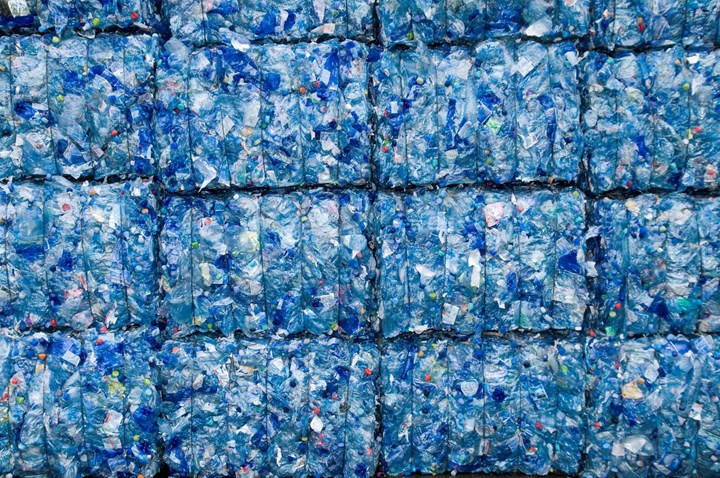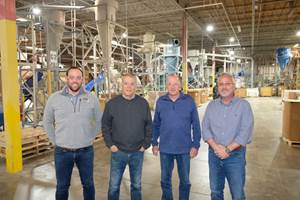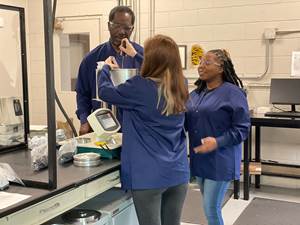What Type of Recycling Technology Works the Best? It Depends
NREL scientists describe a framework for comparing recycling technologies.
An article published January 12th in the ACS journal Sustainable Chemistry & Engineering quantifies and compares the merits of recycling technologies for major commercially produced polymers. The strategy, developed by a team at the National Renewable Energy Laboratory, illuminates differences in the technical performance of produced material as well as environmental and economic impacts.
The recycling of HDPE, LDPE, and PP by mechanical means and dissolution were compared with the production of virgin resin. For recycling PET, glycolysis, methanolysis, and enzymatic hydrolysis were also included. Notably, the researchers assessed only closed-loop recycling, and concluded that pyrolysis is currently too energy intensive and too low-yield in a closed-loop implementation.

The contamination level of available feed streams effects recycling processes differently across technologies.
Photo Credit: Getty
The Multidimensionality of Recycling Technologies
Materials are less likely to leak out of waste streams if they are recovered and returned to production streams. Much of the momentum around recycling stems from this potential to reduce the burden on waste management and simply reduce leakage by reducing volume. But this is one environmental impact of production (of plastic or anything else). The NREL study also includes water use, land use, energy use, greenhouse gas emissions, and toxicity. Each process has its strong points, but mechanical recycling shines across the board when it comes to environmental impact.
In some of the technical merits, mechanical recycling lags other processes. For example, it is much less able to deal with contaminated PET than any of the other evaluated technologies. The end product also sells for rather less, though the authors point out that the lower startup costs compensate for the price difference. Technologies are also scored for product material quality (by melt flow ratio), material retention, circularity, and readiness level (the maturity of the technology).
The One Recycling Process for Every Plastic Product
More investments are going toward recycling plastics using a variety of methods, bringing reactions from laboratory benchtops to industrial scale facilities. Whether the process is formalized in charts like those drafted by the NREL group or not, these decisions are based on the prioritization of performance, economic, and environmental metrics. The same holds for public policy.
This approach does not give one answer. I mentioned that mechanical recycling does well with respect to all the environmental metrics. But in a PET recycling scenario where land use is the critical method, perhaps enzymatic hydrolysis should be considered (especially if the feedstock is contaminated with other plastics). Not only is everything dependent on the polymer and quality of the feedstream, but each technology is likely to mean something different for each manufacturer, policymaker, or citizen depending on their priorities.
Adaption to Future Conditions
In considering the suitability of technologies for long-term use, we might think about how conditions are likely to change. Greenhouse gas emissions data are based on the current US energy mix, which is changing rapidly. Robustness to contamination is a must today, but could be less so in a world with improved sorting, a bottle bill or other enhancement to collection systems. The recycling processes themselves are likely to change as they are refined, scale up, and are joined by new developments.
Related Content
Compatibilizers Aid Recycling & Upcycling of Mixed Resins
Compatibilizers are proving their worth in boosting critical properties such as impact/stiffness balance of PCR and PIR blends of polyolefins and other plastics.
Read MoreEvolving Opportunities for Ambitious Plastics Recycler
St. Joseph Plastics grew from a simple grinding operation and now pursues growing markets in recycled PP, food-grade recycled materials, and customized post-industrial and post-consumer compounds.
Read MoreSD Polymers: 'One-Stop Solution for Mechanical Recycling'
‘Passionate’ recycler invests in people and technology to meet commitment to innovative, sustainable solutions for its processor customers.
Read MoreRecycling: What's Ahead in Advanced Sorting Technology
As the industry tries to ramp up recycling, there are several innovative sorting solutions in the offing—ranging from enhanced optical sorting technologies and chemical tracers to advanced solutions based digital watermarks and artificial intelligence.
Read MoreRead Next
Lead the Conversation, Change the Conversation
Coverage of single-use plastics can be both misleading and demoralizing. Here are 10 tips for changing the perception of the plastics industry at your company and in your community.
Read MoreUnderstanding Melting in Single-Screw Extruders
You can better visualize the melting process by “flipping” the observation point so that the barrel appears to be turning clockwise around a stationary screw.
Read MoreProcessor Turns to AI to Help Keep Machines Humming
At captive processor McConkey, a new generation of artificial intelligence models, highlighted by ChatGPT, is helping it wade through the shortage of skilled labor and keep its production lines churning out good parts.
Read More












.png;maxWidth=300;quality=90)













